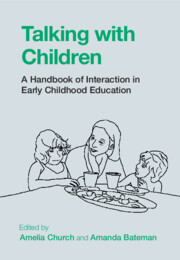Book contents
- Talking with Children
- Talking with Children
- Copyright page
- Dedication
- Contents
- Figures
- Tables
- Contributors
- Acknowledgements
- Notes on Transcription Conventions
- Introduction
- Part I Talk as Social Action
- Part II Pedagogy in Interaction
- Part III Interaction and Inclusion
- 15 Play
- 16 Mental Health and Wellbeing
- 17 Neurodiversity
- 18 Friendships
- 19 Conflict
- 20 Morality
- 21 Families
- Index
- References
19 - Conflict
from Part III - Interaction and Inclusion
Published online by Cambridge University Press: 16 June 2022
- Talking with Children
- Talking with Children
- Copyright page
- Dedication
- Contents
- Figures
- Tables
- Contributors
- Acknowledgements
- Notes on Transcription Conventions
- Introduction
- Part I Talk as Social Action
- Part II Pedagogy in Interaction
- Part III Interaction and Inclusion
- 15 Play
- 16 Mental Health and Wellbeing
- 17 Neurodiversity
- 18 Friendships
- 19 Conflict
- 20 Morality
- 21 Families
- Index
- References
Summary
The aim of this chapter is to provide an overview of what we know about young children’s peer conflict in early childhood educational settings and how teachers can support children to develop skills in conflict resolution. This chapter begins with a review of the types of disputes in the early years, how children respond to opposition from other children and a discussion of learning opportunities in the practices of negotiation and compromise. The discussion also shows that teacher intervention is either solicited by children when they are stuck in a repetitive stalemate or instigated by the teacher when disputes escalate. Data extracts illustrate how intervention can be managed productively, where teachers guide children to identify and implement solutions. The analysis shows that intervention is most effective when the teacher monitors and encourages the uptake of solutions proposed by the children themselves. Finally, this chapter outlines implications for practice in early childhood education, in supporting children to resolve disputes.
- Type
- Chapter
- Information
- Talking with ChildrenA Handbook of Interaction in Early Childhood Education, pp. 388 - 404Publisher: Cambridge University PressPrint publication year: 2022
References
- 1
- Cited by



